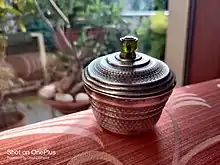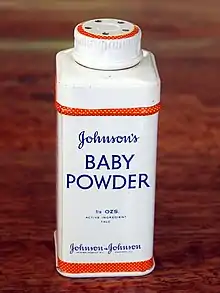Baby powder
Baby powder is an astringent powder used for preventing diaper rash and for cosmetic uses. It may be composed of talc (in which case it is also called talcum powder) or corn starch. It may also contain additional ingredients like fragrances. Baby powder can also be used as a dry shampoo, cleaning agent (to remove grease stains), and freshener.[1]

.jpg.webp)
Health risks
Talcum powder, if inhaled, may cause aspiration pneumonia and granuloma.[2] Severe cases may lead to chronic respiratory problems and death.[3][4] The particles in corn starch powder are larger and less likely to be inhaled.[5]
Some studies have found a statistical relationship between talcum powder applied to the perineal area by women and the incidence of ovarian cancer, but there is not a consensus that the two are linked.[6][7] In 2016, more than 1,000 women in the United States sued Johnson & Johnson for covering up the possible cancer risk associated with its baby powder.[8][9] The company stopped selling talc-based baby powder in the United States and Canada in 2020[10] and has said it will stop all talc sales worldwide by 2023. However, Johnson & Johnson says that its talc-based baby powder is safe to use and does not contain asbestos.[11]
See also
- Talcum powder – Hydrated magnesium phyllosilicate mineral
- Corn starch – Starch derived from corn (maize) grain
References
- "20 Brilliant Uses for Baby Powder You've Never Considered". DIY & Crafts. 2014-07-14. Retrieved 15 August 2014.
- Harper, John; Arnold Oranje; Neil Prose (2000). Textbook of Pediatric Dermatology. Blackwell Science. p. 156. ISBN 978-0-86542-939-0.
- Pairaudeau, P. W.; Wilson, R. G.; Hall, M. A.; Milne, M. (18 May 1991). "Inhalation of baby powder: an unappreciated hazard". BMJ. 302 (6786): 1200–1201. doi:10.1136/bmj.302.6786.1200. PMC 1669894. PMID 2043820.
- Mofenson, H. C.; Greensher, J.; DiTomasso, A.; Okun, S. (August 1981). "Baby Powder—A Hazard!". Pediatrics. 68 (2): 265–6. PMID 7267235.
- Weil, Andrew (8 October 2012). "How Bad Is Baby Powder?". DrWeil.com. Retrieved 22 May 2020.
- Mohan, Melissa; Whysner, John (2000). "Perineal application of talc and cornstarch powders: Evaluation of ovarian cancer risk". American Journal of Obstetrics and Gynecology. 182 (3): 720–724. doi:10.1067/mob.2000.104259. PMID 10739536.
- Mills, Paul; Riordan, Deborah; Cress, Rosemary; Young, Heather (2004). "Perineal talc exposure and epithelial ovarian cancer risk in the Central Valley of California". International Journal of Cancer. 112 (3): 458–464. doi:10.1002/ijc.20434. PMID 15382072. S2CID 2464631.
- "Talcum Powder Lawsuit". MesoWatch. Retrieved 15 August 2019.
- Johnson & Johnson Has a Baby Powder Problem Bloomberg, Retrieved April 20, 2017.
- Hsu, Tiffany; Rabin, Roni Caryn (May 19, 2020). "Johnson & Johnson to End Talc-Based Baby Powder Sales in North America". The New York Times. ISSN 0362-4331. Retrieved May 20, 2020.
- Hoskins, Peter (12 August 2022). "Johnson & Johnson to replace talc-based powder with cornstarch". BBC News. Retrieved 19 August 2022.
